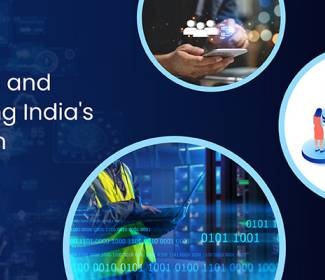India has witnessed a remarkable surge in internet usage in recent years, reflecting the nation’s rapid digital transformation.
Per a recent TRAI report, the average monthly data consumption a user reached 20.27GB as of March 2024, up from just 0.27GB in 2014-15. This reflected a compound annual growth rate (CAGR) of 54%.
The internet subscriber base now stands at 954.4 million, with 556.05 million in urban areas and 398.35 million in rural areas, contributing to a tele-density of 85.7%.
The contribution of different generations of data technology varies, with 4G dominating at 82.7% and 5G — still new in the game — following at 16.9%. This surge in internet usage has profound implications for the telecom sector, driving substantial growth and transformation.
“India's meteoric rise as a digital powerhouse is a testament to the convergence of affordability, technology and aspiration. A decade ago, the digital landscape was still emerging. Today, it’s a dynamic ecosystem driving innovation, job creation and social progress.
“With affordable handsets empowering millions, and 5G revolutionizing connectivity, India is at the cusp of a new era. Invest India envisages a future where the country’s next-gen digital infrastructure is the backbone of the future for a globally competitive economy,” says Vinod Subramanian, Vice President, Technology and Telecom at Invest India.
“It’s ready, evolving and connecting at a fast pace the remotest corners and fostering a society enriched with information and opportunities,” he adds.

Affordable data plans and smartphone proliferation
One of the primary drivers of increased internet usage in India is the affordability of data plans. Competitive pricing and attractive data packs have made internet access more accessible to a broader population, deepening its roots and spreading at a rapid speed.
The average revenue realization per subscriber for per gigabyte (GB) wireless data ranges from ₹8.7 to ₹10.4, positioning India as one of the most affordable markets, globally.
“India's digital transformation has set the stage for unprecedented growth opportunities across sectors where, for example a smart city — empowered by 5G technology, seamless integration of AI-driven applications, LLM-backed real-time data, cloud-enabled repository, digital twins and IoT-enhanced infrastructure — not only connects and serves the need of the future, but creates a society that values sustainability and works in eco-friendly way with supporting infrastructure and technology that are meant for the upcoming,” comments Subramanian.
The proliferation of smartphones has significantly boosted internet access. The count of 660 million smartphone users in India is rising and has accounted for a penetration rate of 46.5%, so far. More people are now connected to the internet than ever before, and you know it.
Creation of reels for example is a teen’s play now with vloggers preferring a sturdy and affordable handset with a good camera as companion.
Smartphones now serve as the primary gateway to the digital world, facilitating everything from social media to online shopping. Looking at the ecommerce market, the upsurge is noticeable with scores of omnichannel platforms keeping users glued to products in innovative ways.
Rising demand for digital services
The demand for digital services has skyrocketed, with activities like streaming, gaming and social media driving data consumption. Coupled with OTT these platforms have become integral to daily life, leading to a substantial increase in data usage.
The convenience of digital services has fundamentally changed how people interact with the internet. The introduction of OTT (or Over The Top) platforms has been well planned, reformed and executed in such a way that now data providers offer you free subscriptions to such OTT platforms.
To handle this increasing traffic, telecom companies are investing heavily in network expansion and upgrades. As of March 2024, the TRAI report mentioned that Reliance Jio held the top position with a 50.4% market share of internet subscribers, followed by Bharti Airtel Ltd. with 30.47% and Vodafone Idea Ltd. with a market share of 14.39%.

Data-centric revenue model and 5G rollout
The surge in internet usage has translated to higher data revenue for telecom companies. Revenue from data usage now comprises about 85% of total revenue per user, highlighting the shift toward a data-centric revenue model.
The need for a robust infrastructure to support high-speed internet is driving substantial capital expenditure in the sector. The growing demand for internet services has made telecom companies shift their focus from voice calls to data-centric offerings.
This includes introducing innovative data plans, value-added services and digital content to attract and retain customers. The rollout of 5G in October 2022 and other technological advancements are poised to further fuel internet usage and telecom sector growth by providing faster speeds, lower latency and more reliable connections.
“This digital revolution not only positions India as a global leader in technology, but also ensures that every citizen, regardless of location, can participate in and benefit from this digital ecosystem. At Invest India, we see this as a pivotal moment to further accelerate the country’s growth trajectory, bringing together innovation, inclusivity and sustainable development on one platform,” adds Subramanian.
Outlook and challenges
Despite the progress, ensuring equitable access to high-speed internet in rural and remote regions is crucial for inclusive growth. As internet usage grows, so do concerns about data privacy and security. Telecom companies must invest in robust security measures to protect user data and maintain trust.
“India's evolution from the bygone 2G phase to the rapid rollout of 5G represents a remarkable evolution in our telecom landscape, showcasing our commitment to becoming a global leader in technology,” says Atul Kumar Chaudhary, Secretary, TRAI.
“This journey not only reflects our dedication and focus on bridging the digital divide, but also positions India as a frontline contributor to the design, development and implementation of the next: 6G technology,” he adds.
The outlook remains promising, with potential for further growth driven by technological advancements and government initiatives. However, addressing challenges such as the rural-urban divide and data security concerns will be crucial for sustaining this growth trajectory.
India continues to advance with experts’ focus continues to remain on building a resilient and robust telecom infrastructure. Here, implementation of stringent data encryption standards — in adherence to comprehensive data protection regulations — are just a few of the critical measures the telecom sector is employing relentlessly.
These opportunities will be instrumental in safeguarding India’s digital ecosystem from rising threats and sophisticated cyberattacks.
“As India continues to build on this momentum, the combination of robust market demand, technological advancements and supportive policies makes it a preferred destination for global investors seeking growth opportunities in the telecom sector,” concludes Subramanian.






